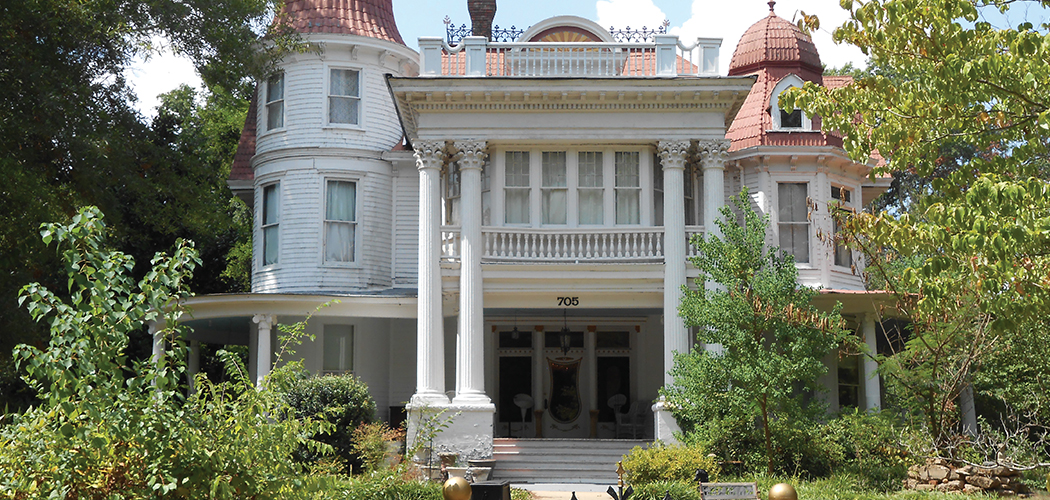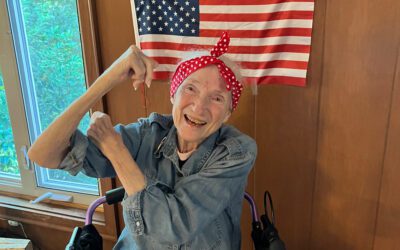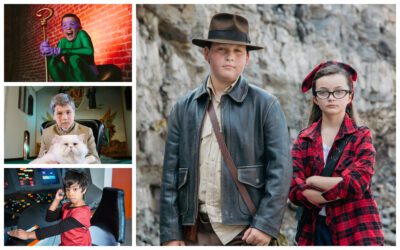[title subtitle=”words and images: Heather Steadham”][/title]
The circumstances leading to Mark Spencer’s occupancy of the Allen House in Monticello, Arkansas are just a little too coincidental for comfort. In 2004, Mark, a tenured professor at Cameron University in Lawton, Oklahoma, had his heart set on becoming the new Dean of Arts and Letters. He updated his CV and scanned the Chronicle of Higher Education’s job listings every day that academic year, waiting for the position to be advertised so he could apply. But on the very day the Cameron job became public, Mark saw another listing that piqued his interest.
“The day the Deanship at Cameron appeared in the Chronicle, right next to it was an ad for the Deanship at the University of Arkansas at Monticello. It caught my eye. I wasn’t thinking of applying anywhere else, to tell you the truth. But it caught my eye, and I thought, well, you know, maybe I should have a plan B. What if they don’t offer me the Deanship at Cameron? The ad made it sound interesting: it was a small school, and I wanted to be able to continue teaching. So I applied for the job on kind of a lark. I had no intentions of applying for other Deanships.”
But apply he did, and when he and his wife Rebecca headed to the Delta town for an interview, something else unexpected happened.
“Our intent was to just drive around, and we happened to drive straight here. We were coming down North Main Street, and it was like, Wow! We’d instantly found the historic part of town. We were admiring all the lovely old houses, and then we came to this house. We stopped the car in the middle of the street, and Rebecca said, ‘If you buy me that house you can take the job here.’”
But that house, The Allen House, wasn’t for sale.
That didn’t stop Mark, though, from taking the job in Monticello. He thought it would be fun to move to a new place and work with new people, so he and Rebecca and their two sons moved into a rental house located on Highway 425. They even went on to buy a different old home—the Hotchkiss House on Boyd Street. But at work and around town, Mark and Rebecca couldn’t help telling anyone and everyone how much they really loved the sprawling Queen Anne/Gothic/Neoclassical home on North Main. People would tell them, “You don’t want to buy that house.”
“Why?” they’d respond.
“Because it’s haunted,” was the invariable answer.
Mark thought that was just as funny as could be. But in a small town like Monticello, word travels fast. Pretty soon, the flamboyant lady who owned the Allen House called Mark and said, “I hear you want to buy my house.”
“Well, my wife and I really love your house,” Mark replied. “Would you consider selling it?”
“I might,” she declared. “If I like you.”
So Mark and Rebecca went to visit. “She liked us,” Mark says. “And she said she had a feeling that we were supposed to live here. She’d never had that feeling. She never thought she’d sell the house, but now she thought she would.”
And she did.
In the summer of 2007, Mark and his family moved into the notoriously haunted house. At the time, he didn’t believe that ghosts roamed the 8,000-square-foot home. He knew the history of the place: How Allen Boyd, grandson of original owner Joe Lee Allen, died in 1944, and residents of the house often heard his mother, Ladell, talking to him late at night after his death. How Ladell, at the age of fifty-four, had poisoned herself in the upstairs master bedroom on Christmas night in 1948 after an affair with a married man had gone sour. How, for more than half a century, residents and guests and townspeople alike knew of the six or more ghosts that haunted the place. But Mark just flat didn’t believe. In fact, for the first year they lived there, he
declined any paranormal investigator who asked permission to enter.
But pretty soon, he and Rebecca began to have “experiences.”
“My wife had seen things, smelled things,” Mark explains. “We had some interesting experiences with our son Jacob—it’s called doppelganger phenomenon (a doppelganger is an apparition or a double of a living person). For instance, one morning shortly after we moved in, I was in the kitchen downstairs with Jacob. Rebecca came downstairs and stopped in the doorway and looked at Jacob and said, ‘How did you get down here so quickly?’ And I said, ‘Well, he’s been down here with me for twenty or thirty minutes, and she said ‘No, he was just upstairs in the hallway.’”
Mark himself had a brush with a doppelganger on the very day the family moved into the Allen House: “I was carrying boxes in the side door and Jacob was standing right here by this side staircase. He was watching me carry boxes in and I kind of turned and as I set the boxes down I said, ‘Well, how do you like your new house?’ He didn’t say anything, and when I turned back he wasn’t there. A few minutes later I went upstairs and found him watching a movie. I said, ‘Why didn’t you say anything? I asked how you liked the house.’ He said, ‘What are you talking about?’ I said, ‘A few minutes ago you were standing by the staircase downstairs.’ ‘I haven’t been down there since breakfast,’ he told me.”
As time went by, Mark did allow paranormal investigators to explore his home. The Allen House has been featured on the Biography Channel’s My Ghost Story and Discovery’s A Haunting and SyFy’s Paranormal Witness, to name a few. But even after a group called Louisiana Spirits recorded forty-seven EVPs (Electronic Voice Phenomenon, sounds found on electronic recordings that are not easily explained as anything other than the voices of ghosts), Mark still wasn’t convinced.
“I didn’t know why someone would be conning me—why they would fake these EVPs—but there was still that nagging doubt,” Mark says. “So I went up to the attic one night by myself with a recorder and I decided to have my own EVP session. I went up there and asked Ladell some questions. I didn’t spend more than fifteen minutes up there. I played back what I had recorded, and she had answered me. What was really compelling about this wasn’t just the fact that she distinctly answered my questions; I mean, she answered me in complete sentences. I said, ‘Do you like being here?’ and she said ‘Yes, I like being here.’ She wanted me to know that she was deliberately answering my questions. That’s when I became a believer.”
Mark has had innumerable encounters since that time. One of the eeriest happened early one summer morning. He woke up with a feeling that he should go up into the 2,000-square-foot attic. He tried to ignore that feeling—shake it off—but after about thirty minutes of a ceaseless, nagging sensation, he gave in and marched upstairs. “I walked directly over to the edge of the south turret room and looked down at a little opening in the floor. I just stood there and stared down at it, wondering what I was doing. There was like a voice in my head telling me I needed to look more closely, and I got down on my knees and looked and finally I noticed that there was a brown piece of paper under the floorboard.”
He reached under the floorboard, thinking there was a little newspaper, maybe, down there, and he pulled out a brown envelope. Inside that envelope? Love letters. Almost ninety in total. “They were addressed to Ladell Allen Bonner,” Mark says. “Addressed ‘Dearest’ and signed ‘Love, P.’ I realized this was a love letter written to Ladell two months before she committed suicide.”
How does Mark explain this sudden urge to go to the attic? Why was it so significant that he found those letters when he did?
“The explanation I have is that Ladell wanted me to find those letters,” he postulates. “She decided it was time. She wanted me to tell her story.”
Ridiculous, right? Just because he ended up in Monticello for a job he never intended to apply for, and bought a house that wasn’t for sale, and found some letters hidden beneath a floorboard—that’s not enough to justify the existence of a haunting, is it? By the end of our visit, I wasn’t so sure.
Remember that rental house the Spencers lived in when they first moved to Monticello? Turns out the original owner of that home was Virginia Lucky, Ladell’s best friend. And the Hotchkiss House—the one they bought before they moved into the Allen House? It belonged to Sylvester Hotchkiss, the architect for the Allen House. Still not convinced?
Mark says, “Rebecca and I were doing some research regarding the individuals mentioned in the letters. One was Martha Jones, Ladell’s niece. Ladell and Martha were very close. Ladell lost her son in 1944 , the same year Martha lost her mother, so Ladell became Martha’s surrogate mother. And one of the things we found the day after I discovered the letters is that Martha had just died that week. She was the last living person who knew Ladell—who’d had any kind of relationship with her. Martha was the last person who would feel any embarrassment about the revelations, so once Martha passed, it was time.”
So many things Mark says make sense—that he was destined to come to Monticello and live in this house and find
the letters and tell Ladell’s story. But once I’m out of the house, that mystical, otherworldly feeling dissipates immediately. It’s like I’m just waking up from a spooky dream caused by watching too much Twilight Zone.
But when I get home, and listen to my own recording of the interview, I find that at twelve minutes and nine seconds into our conversation, when I am asking Mark how he came up with the names of his other children—born since they’ve lived in the Allen House—there is a whispery voice that I just cannot quite explain away saying “I would know.”




